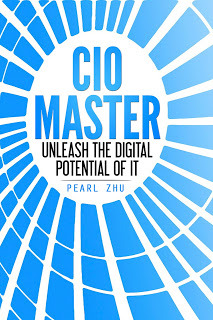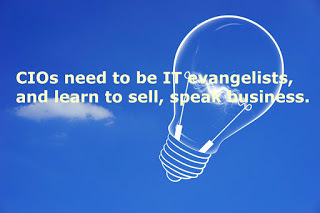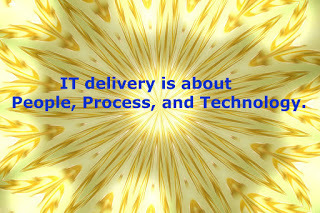Pearl Zhu's Blog, page 1350
April 7, 2016
Three Questions to Assess a Person’s Professional Uniqueness
 The digital dynamic continues to evolve with increasing speed of change and rapid integration of the business across the globe. Talent Management is throwing fresh challenges and calls for radical change to be embraced as well. If the talent philosophy in the industrial age is about setting the cookie-cutter standard to find human resource filling the square hole, and keep the business wheel spinning; and then, at the Digital Age, with increasing speed of change and continuous disruption, innovation is not just “nice to have,” but “must have” business capability, how would you discover creative people? How do you define wrong, average, mediocre, good, great or extraordinary person? Or put simply, for what should they be right? Which questions shall you ask to discover a person’s professional uniqueness in order to assess his/her creativity potential?
The digital dynamic continues to evolve with increasing speed of change and rapid integration of the business across the globe. Talent Management is throwing fresh challenges and calls for radical change to be embraced as well. If the talent philosophy in the industrial age is about setting the cookie-cutter standard to find human resource filling the square hole, and keep the business wheel spinning; and then, at the Digital Age, with increasing speed of change and continuous disruption, innovation is not just “nice to have,” but “must have” business capability, how would you discover creative people? How do you define wrong, average, mediocre, good, great or extraordinary person? Or put simply, for what should they be right? Which questions shall you ask to discover a person’s professional uniqueness in order to assess his/her creativity potential?
Authenticity: Every person is unique, no two snowflakes are the same. Being unique means to be authentic. Being authentic is defined as being real or genuine. But what does "real" mean? To what standard are we being genuine? Daring to start to find an answer to this question enables anybody to lead oneself and possibly others. Defining your true purpose is a helpful instrument to guide yourself, your team, your business, and your relations along the other dimensions. Through authenticity lens, it is more clearer to discover an individual’s capabilities and potential to innovate. The indicators to assess the intrinsic capacity of individuals like: Self-awareness (recognition of one's strength and weaknesses), interdisciplinary skills and knowledge, cognitive ability & style, intellectual engagement, creative problem-solving, personality (openness to experience, tolerance of ambiguity, personal initiatives), tendency to constantly question the status quo,plasticity (fast learning), ability to identify patterns, ability to make unusual connections, capacity to adapt, emotional intelligence (risk taking), willingness to accept feedback and/or a tenacity to refuse it, etc.
Cognitive ability & style: All of us have a creative/artistic side while also having a curious/scientific side. Cognition is a faculty for processing of information, applying knowledge, and changing preferences. Cognition can happen in many different ways and their combinations, for example, enhancing our “description of the world and ourselves within it” - is cognition and differs from ordinary (usually habitual) thoughts. The next step for discovering professional uniqueness is investigating what’s your strength, your passion: defining your task, things you want to do and do better than others. The emphasis is on trying to determine which competencies or capabilities should be used in which combination, and with what level of weight for each, for every different situation. Improving one’s cognitive ability involves exploring varieties of meanings/thoughts, abandoning old connection, and establishing new relations. In neuronal terms, this involves disabling some of the “wiring” and working on the new ones. All of that requires a deliberate mental effort, connect your dots and discover where your unique value proposition is...and how to become more creative effortlessly.
 The unique set of capability: Either at individual or business level, the unique set of capability will help you to achieve career or business goals. Competency is a combination of capabilities with a focus. Each of these same capabilities may be combined in different fashions to yield multiple competencies. For example, creative problem-solving is a unique capability, creative minds with cognitive differences can reframe questions before answering them, to focus on WHY, before getting to the HOW. In short, innovators obviously think differently- problem solving is part of their DNA whether it is in the invention, marketing, repurposing something already being there. Creative people also have the ability to reframe the circumstances or conditions around a problem, to solve a problem creatively. Creative thinking starts with big WHY, start focusing on why the tasks are necessary. When you begin looking at WHYs, benchmarks can be set for the improvement activities of the future. You will also drive greater innovation and change since you will find that you have more options available to solve your problems.
The unique set of capability: Either at individual or business level, the unique set of capability will help you to achieve career or business goals. Competency is a combination of capabilities with a focus. Each of these same capabilities may be combined in different fashions to yield multiple competencies. For example, creative problem-solving is a unique capability, creative minds with cognitive differences can reframe questions before answering them, to focus on WHY, before getting to the HOW. In short, innovators obviously think differently- problem solving is part of their DNA whether it is in the invention, marketing, repurposing something already being there. Creative people also have the ability to reframe the circumstances or conditions around a problem, to solve a problem creatively. Creative thinking starts with big WHY, start focusing on why the tasks are necessary. When you begin looking at WHYs, benchmarks can be set for the improvement activities of the future. You will also drive greater innovation and change since you will find that you have more options available to solve your problems.
It is a digital shift from managing people as resources and cost to investing them as asset and capital, from static monitoring to ongoing development, besides wise eyes to identify talent, ask the good questions to discover the unique value of your talented people, put the right people with the right capability to the right position to solve the right problems, make digital talent management both the art and science.
Follow us at: @Pearl_Zhu
Published on April 07, 2016 23:35
CIO Master Intense Tuning I: Three Core Capabilities of Digital IT
 The purpose of CIO Master - Unleash the Digital Potential of IT is to provide guidelines for building a framework to run a highly effective, highly innovative and highly mature digital IT organization. CIOs as IT leaders must be able to develop and optimize IT operational functions and build a set of necessary and differentiated capabilities to run multidimensional IT for creating multi-level business value. What are core capabilities of a digital IT and how to run IT as an enabler for the business strategies and objectives?
The purpose of CIO Master - Unleash the Digital Potential of IT is to provide guidelines for building a framework to run a highly effective, highly innovative and highly mature digital IT organization. CIOs as IT leaders must be able to develop and optimize IT operational functions and build a set of necessary and differentiated capabilities to run multidimensional IT for creating multi-level business value. What are core capabilities of a digital IT and how to run IT as an enabler for the business strategies and objectives?
Information Management capability: IT is the foundation of data, information, and modern knowledge. The biggest misnomer regarding IT is that it is "just technology." The most powerful and differentiating tool in all of the today's businesses is INFORMATION and that, is provided by IT systems. The fact is that a huge percentage of IT is about the identification and advancement of knowledge for the enterprise and its people. Anyone with common sense can perceive that, and all forward-looking businesses are declaring they are in the information business regardless of the sectors and nature of business. In fact, most experienced people would debate that, in this digital information age, there isn't really much of an enterprise without the massive oceans of Data & Information that flow through the enterprise, at any given split second. This information is open to interpretation accordance to the level of knowledge one has. IT is the foundation for massive volumes of data and information that is collected, persisted, categorized, mapped, sliced, diced, reordered, related, transformed, abstracted, and made meaning of, without which knowledge would be minimal in the modern day. Information Management is to connect people with the right information at the right time & location, to ensure that accurate information is accessible and shared within relevant business units. The role of IT today for many organizations is a business 'solutionary' for information, automation, and orchestration - although the real goal is, as is the case with every part of the organization, helping the business become, stay, and increase profitability! The role of IT in the current business environment should be able to enable business outcomes. Business is no more interested in IT, if it continually delivers projects without delivering the real business value.
Innovation capability: Digital IT is a paradigm shift in role, responsibility and attitude. CIO role has never been about just managing the status quo, so the digital shift for IT across industries is to be innovative with systems of engagement. The available digital technologies just make innovation easier to do now than in the past - less costly, more easily accessible. IT leaders need to manage innovation portfolio including both incremental innovation and disruptive innovation in a systematic way. Unfortunately, in most of the organizations, innovation is still a serendipity. An enterprise that depends on doing something, again and again, engaging various teams and groups, have less appetite for change. Incremental innovation can be tolerated to some extent, but disruptive innovation is almost impossible unless the company is going through a crisis. Even in the case of a crisis, most of the time, change of the leadership is required to accept disruptive innovation. An innovative and value-driven IT needs to understand stakeholders’ expectations and propose an innovation solution portfolio that corresponds to both demand and cost drivers with a focus on business priority,
 Changeability/Agility: Agile is better at adapting to changes and ensuring quality. In the context of IT, from the highest strategic to the deepest technical levels, "agility" is a fast, sure response to external stimuli. It is the ability to "pivot" and change direction in response to market pressure, or to create the market opportunity. It requires distinct patterns of IT capabilities, with specific positioning in the organization. Agile is the mind shift. Agile leverages the wisdom of the masses to scale up and drive success. For forward-looking and highly mature organizations, the IT department has become synonymous with the change department. The IT department has been left to run change project, to have a good understanding from a strategic perspective of the organization (structure, processes, locations, drivers, objectives, goals, applications, data, technologies.). In order to make effective changes, you have to know the underneath structure and processes of your business, because they underpin digital capabilities of the organization. How do you make changes to anything without knowing all the parts and how they are related? A mature organization is one that can quickly and safely assess all of the consequences of a possible change and devise effective plans to achieve and sustain those changes - and to do this continuously. To be flexible you need to be able to change and you can't make effective change decisions if you don't know where you are. Fundamentally, change consists of one or more of the following: people change, process change, and technology change, and IT is not only the superglue but also the integrator to weave all important change elements effortlessly and make change sustainable.
Changeability/Agility: Agile is better at adapting to changes and ensuring quality. In the context of IT, from the highest strategic to the deepest technical levels, "agility" is a fast, sure response to external stimuli. It is the ability to "pivot" and change direction in response to market pressure, or to create the market opportunity. It requires distinct patterns of IT capabilities, with specific positioning in the organization. Agile is the mind shift. Agile leverages the wisdom of the masses to scale up and drive success. For forward-looking and highly mature organizations, the IT department has become synonymous with the change department. The IT department has been left to run change project, to have a good understanding from a strategic perspective of the organization (structure, processes, locations, drivers, objectives, goals, applications, data, technologies.). In order to make effective changes, you have to know the underneath structure and processes of your business, because they underpin digital capabilities of the organization. How do you make changes to anything without knowing all the parts and how they are related? A mature organization is one that can quickly and safely assess all of the consequences of a possible change and devise effective plans to achieve and sustain those changes - and to do this continuously. To be flexible you need to be able to change and you can't make effective change decisions if you don't know where you are. Fundamentally, change consists of one or more of the following: people change, process change, and technology change, and IT is not only the superglue but also the integrator to weave all important change elements effortlessly and make change sustainable.
Either information or technology is meant to the end, not the end. Many companies don't seem to have learned the lessons of each wave of new systems over the years that a system can only provide value if you have a clear understanding of how you will use it. In the book “CIO Master - Unleash the Digital Potential of IT,” we systematically discuss the digital CIO’s vision, how to build a capability-based strategy and implement it with step wise methodology and practices, also how to measure the right things, and measure them right.
CIO Master Order Link on AmazonCIO Master Ordre Link on Barner & NobleCIO Master Order LinkOn IBooks
“CIO Master” Book Preview Quote Collection I, Slideshare Presentation“CIO Master” Book Preview Conclusion Running IT as Digital Transformer“CIO Master” Book Preview: Chapter 9 IT Agility“CIO Master” Book Preview: Chapter 8 Three "P"s in Running Digital IT“CIO Master” Book Preview: Chapter 7 IT Innovation Management“CIO Master” Book Preview: Chapter 6 Digital Strategy-Execution Continuum"CIO Master” Book Preview: Chapter 5 Thirteen Digital Flavored IT“CIO Master” Book Preview: Chapter 4 CIO as Talent Master Introduction“CIO Master” Book Preview: Chapter 3 “CIOs as Change Agent” Introduction“CIO Master” Book Preview: Chapter 2 “CIOs as Digital Visionary” Introduction“CIO Master” Book Preview: Chapter 1 “Twelve Digital CIO Personas” Introduction"CIO Master - Unleash the Digital Potential of IT" Introduction
"CIO Master - Unleash the Digital Potential of IT" Book Preview
Follow us at: @Pearl_Zhu
Published on April 07, 2016 23:32
CIO Master Intense Tuning one: Three Core Capabilities of Digital IT
 The purpose of CIO Master - Unleash the Digital Potential of IT is to provide guidelines for building a framework to run a highly effective, highly innovative and highly mature digital IT organization. CIOs as IT leaders must be able to develop and optimize IT operational functions and build a set of necessary and differentiated capabilities to run multidimensional IT for creating multi-level business value. It is one thing to run IT as an enabler for the business strategies and objectives.
The purpose of CIO Master - Unleash the Digital Potential of IT is to provide guidelines for building a framework to run a highly effective, highly innovative and highly mature digital IT organization. CIOs as IT leaders must be able to develop and optimize IT operational functions and build a set of necessary and differentiated capabilities to run multidimensional IT for creating multi-level business value. It is one thing to run IT as an enabler for the business strategies and objectives.
Information Management capability: IT is the foundation of data, information, and modern knowledge. The biggest misnomer regarding IT is that it is "just technology." The most powerful and differentiating tool in all of the today's businesses is INFORMATION and that, is provided by IT systems. The fact is that a huge percentage of IT is about the identification and advancement of knowledge for the enterprise and its people. Anyone with common sense can perceive that, and all forward-looking businesses are declaring they are in the information business regardless of the sectors and nature of business. In fact, most experienced people would debate that, in this digital information age, there isn't really much of an enterprise without the massive oceans of Data & Information that flow through the enterprise, at any given split second. This information is open to interpretation accordance to the level of knowledge one has. IT is the foundation for massive volumes of data and information that is collected, persisted, categorized, mapped, sliced, diced, reordered, related, transformed, abstracted, and made meaning of, without which knowledge would be minimal in the modern day. Information Management is to connect people with the right information at the right time & location, to ensure that accurate information is accessible and shared within relevant business units. The Role of IT today for many organizations is solutionary for information, automation, and orchestration - although the real goal is, as is the case with every part of the organization, helping the business become, stay, and increase profitability! The role of IT in the current business environment should be able to enable business outcomes. Business is no more interested in IT, if it continually delivers projects without delivering business value.
Innovation capability: Digital IT is a paradigm shift in role, responsibility and attitude. CIO role has never been about just managing the status quo, so the digital shift for IT across industries is to be innovative with systems of engagement. The available digital technologies just makes innovation easier to do now than in the past - less costly, more easily accessible. IT leaders need to manage innovation portfolio including both incremental innovation and disruptive innovation in a systematic way. Unfortunately, in most of the organizations, innovation is still a serendipity. An enterprise that depends on doing something, again and again, engaging various teams and groups, have less appetite for change. Incremental innovation can be tolerated to some extent, but disruptive innovation is almost impossible unless the company is going through a crisis. Even in the case of a crisis, most of the time, change of the leadership is required to accept disruptive innovation. An innovative and value-driven IT needs to understand stakeholders’ expectations and propose an innovation solution portfolio that corresponds to both demand and cost drivers with a focus on business priority,
 Changeability/Agility: Agile is better at adapting to changes and ensuring quality. In the context of IT, from the highest strategic to the deepest technical levels, "agility" is a fast, sure response to external stimuli. It is the ability to "pivot" and change direction in response to market pressure, or to create market opportunity. It requires distinct patterns of IT capabilities, with specific positioning in the organization. Agile is the mind shift. Agile leverages the wisdom of the masses to scale up and drive success. For forward-looking and highly mature organizations, the IT department has become synonymous with the change department. In order to make effective changes, you have to know the underneath structure and processes of your business, because they underpin digital capabilities of the organization. How do you make changes to anything without knowing all the parts and how they are related? A mature organization is one that can quickly and safely assess all of the consequences of a possible change and devise effective plans to achieve and sustain those changes - and to do this continuously. The IT department has been left to run change project, to have a good understanding from a strategic perspective of the organization (structure, processes, locations, drivers, objectives, goals, applications, data, technologies.). To be flexible you need to be able to change and you can't make effective change decisions if you don't know where you are. Fundamentally, change consists of one or more of the following: people change, process change, and technology change, and IT is not only the superglue but also the integrator to weave all important change elements effortlessly and make change sustainable.
Changeability/Agility: Agile is better at adapting to changes and ensuring quality. In the context of IT, from the highest strategic to the deepest technical levels, "agility" is a fast, sure response to external stimuli. It is the ability to "pivot" and change direction in response to market pressure, or to create market opportunity. It requires distinct patterns of IT capabilities, with specific positioning in the organization. Agile is the mind shift. Agile leverages the wisdom of the masses to scale up and drive success. For forward-looking and highly mature organizations, the IT department has become synonymous with the change department. In order to make effective changes, you have to know the underneath structure and processes of your business, because they underpin digital capabilities of the organization. How do you make changes to anything without knowing all the parts and how they are related? A mature organization is one that can quickly and safely assess all of the consequences of a possible change and devise effective plans to achieve and sustain those changes - and to do this continuously. The IT department has been left to run change project, to have a good understanding from a strategic perspective of the organization (structure, processes, locations, drivers, objectives, goals, applications, data, technologies.). To be flexible you need to be able to change and you can't make effective change decisions if you don't know where you are. Fundamentally, change consists of one or more of the following: people change, process change, and technology change, and IT is not only the superglue but also the integrator to weave all important change elements effortlessly and make change sustainable.
Either information or technology is meant to the end, not the end: Many companies don't seem to have learned the lessons of each wave of new systems over the years that a system can only provide value if you have a clear understanding of how you will use it. In the book “CIO Master - Unleash the Digital Potential of IT,” we systematically discuss the digital CIO’s vision, how to build a capability-based strategy and implement it with step wise methodology and practices, also how to measure the right things, and measure them right.
CIO Master Order Link on AmazonCIO Master Ordre Link on Barner & NobleCIO Master Order LinkOn IBooks
“CIO Master” Book Preview Quote Collection I, Slideshare Presentation“CIO Master” Book Preview Conclusion Running IT as Digital Transformer“CIO Master” Book Preview: Chapter 9 IT Agility“CIO Master” Book Preview: Chapter 8 Three "P"s in Running Digital IT“CIO Master” Book Preview: Chapter 7 IT Innovation Management“CIO Master” Book Preview: Chapter 6 Digital Strategy-Execution Continuum"CIO Master” Book Preview: Chapter 5 Thirteen Digital Flavored IT“CIO Master” Book Preview: Chapter 4 CIO as Talent Master Introduction“CIO Master” Book Preview: Chapter 3 “CIOs as Change Agent” Introduction“CIO Master” Book Preview: Chapter 2 “CIOs as Digital Visionary” Introduction“CIO Master” Book Preview: Chapter 1 “Twelve Digital CIO Personas” Introduction"CIO Master - Unleash the Digital Potential of IT" Introduction
"CIO Master - Unleash the Digital Potential of IT" Book Preview
Follow us at: @Pearl_Zhu
Published on April 07, 2016 23:32
April 6, 2016
Five Ingredients in Digital Leadership
 Substantially, leadership is all about future and change; direction and dedication; influence and innovation. With “VUCA” characteristics of digital new normal and today’s cross-functional, cross-cultural, and cross-generational workforce, what are the important ingredients and emergent trends for digital leadership, and how to leapfrog leadership to the next level of maturity?
Substantially, leadership is all about future and change; direction and dedication; influence and innovation. With “VUCA” characteristics of digital new normal and today’s cross-functional, cross-cultural, and cross-generational workforce, what are the important ingredients and emergent trends for digital leadership, and how to leapfrog leadership to the next level of maturity?
Vision: Leadership is forward-looking, to make progress. Leadership starts with having a vision, then developing a plan to achieve it. Top leaders are visionary roles, they set the direction for the enterprise (internal and/or external) to step into the uncharted water, and they orchestrate the digital transformation of an organization, its people, from the organization's current position to a position that best serves the interests of its customers, shareholders, and people. The means of 'orchestrate the transformation’ is, what distinguishes a great leader and a great organization. A great leader is one that can trust his or her instincts and relies on them at a crucial moment. Not that you wouldn't let the facts speak for themselves, however, how many times does the leader simply take in all opinions surrounding them and at the end of the day must do what they believe is right for the situation at hand. In all cases, a vision of the future is the key to getting started as a digital leader. If top leaders are not visionary, then they should not be called a CxO. A CxO must be able to add value to an organization through strategy, and strategic thinking involves being visionary.
Intelligence: What keeps leaders successful is the intellectual curiosity and ability to continuously be open to learning and applying these learnings as they move forward. Their inquisitiveness makes them more open to asking the right questions, embrace the other point of view, be empathetic to understand others, practice leadership without prejudice. The authentic leaders with high and multi-intelligence have inquisitiveness, adaptability, consistency, and empathy to master business dynamic and cultural cognition. They present the ability and wisdom to manage complexity in high digital transparency and stressful digital dynamic. They can make a fair judgment and better decisions by analyzing and synthesizing information accordingly. “Believe half of what you see, nothing that you hear, and everything you feel." - Nick C. Ciccone
Creativity: Creativity is the #1 skill in demand in the Digital Era. Hence, creative leaders have also emerged to lead digital transformation effortlessly. Creativity is not a "thing," it´s a process that happens as a proactive mental activity to a problem. Creativity is as much defined by the problem as by the capacity of the individual to connect things to resolve that problem in new and sometimes unexpected ways. Creative leadership is essentially anchored on the leader's overall multifaceted resourcefulness. That is, the multidimensional (including introspection) competencies to formulate creative, unconventional alternatives or solutions to resolve problems, to show versatility and flexibility in response to unpredictable or unanticipated circumstances. Great leaders are pioneers, innovators, and creators of a better context. Creativity becomes significantly important in the age with the advanced technologies because the leaders of the future will not be mere automatons. Creative leadership is the unique combination of a growth mindset and leadership behaviors that develop and achieves high-quality results over a sustained period of time and risk tolerance.
Thought leadership: At today’s “digital dynamic with VUCA” (Velocity, Uncertainty, Complexity, and Ambiguity) characteristics, Being thoughtful, mindful and multi-dimensional thinker is more crucial to improve leadership effectiveness. Authenticity is the foundation to be a Thought Leader. Digital leadership is less about "HOW," more about "WHY," and “WHAT.” Leadership brand is less about what you look - the stereotypical leadership, and more about what you think - Thought Leadership. The digital Thought Leaders of the future sense, feel, read, imagine and intuit possibilities in the digital paradigm shift. The digital brainstorming is happening in real time with people and plays spontaneous networks of human and business operational concerns, to co-solve many thorny problems and overcome numerous challenges facing humanity. Being a Thought Leader also means you truly understand the purpose of leadership. Why do you want to be a leader, and which value can you bring in. Being able to quickly articulate the value that you bring to others is critical to helping others learn about how you can benefit them. For example, if using one word to convey your leadership brand, what would it be - Innovation, Wisdom, Empathy, Authenticity, Visionary, etc, or the opposite -Dictatorship, Stupidity, Narcissism, or Fake., etc. If you are unclear about your own value, others have no hope of understanding how you can help them, and will move on to someone they can understand.
 Profundity: Back to the root of the word “profundity,” it means insightful and understanding. Climbing Knowledge-Insight-Wisdom pyramid is important steps in gaining profundity. It’s not just about knowing, but in-depth understanding; it requires a person's ability to grasp or comprehend information, too often assumptions and prejudices get in the way of understanding. It is the responsibility of each leader to examine themselves and to make sure they are open to true understanding. A mindful or thoughtful leader has a better perception to be a good communicator upon thinking profoundly, upon knowing when to voice out, when to keep silent; upon striking the right balance without any sort of extreme thinking or bias.
Profundity: Back to the root of the word “profundity,” it means insightful and understanding. Climbing Knowledge-Insight-Wisdom pyramid is important steps in gaining profundity. It’s not just about knowing, but in-depth understanding; it requires a person's ability to grasp or comprehend information, too often assumptions and prejudices get in the way of understanding. It is the responsibility of each leader to examine themselves and to make sure they are open to true understanding. A mindful or thoughtful leader has a better perception to be a good communicator upon thinking profoundly, upon knowing when to voice out, when to keep silent; upon striking the right balance without any sort of extreme thinking or bias. As the world moves into a hyper-connected and interdependent digital relationship age, the five ingredients above are defining qualities that will distinguish great leaders from the rest, to go deeper, not louder; first, understand, then be understood; first listen, then make a conversation; first envision, then communicate; first observe, then perceive; first learn to absorb knowledge, then connect the dots, capture insight, and gain wisdom. Leadership wisdom makes the human world go round, being coherent with its physical shape and being harmonized with nature ecosystem.Follow us at: @Pearl_Zhu
Published on April 06, 2016 22:56
The Book “CIO Master” Quote Collection (Part I)
Digital CIOs Rise for Change!
 The purpose of CIO Master - Unleash the Digital Potential of IT is to provide guidelines for building a framework to run a highly effective, highly innovative and highly mature digital IT organization. Also, it provides the principles to reinvent CIO leadership via practicing multitudes of digital influence. Rebrand digital CIOs with multiple personas Reinvent IT to unleash its full digital potentialReenergize change as an ongoing digital capabilityRefine talent management to bridge IT skills gapRemaster multidimensional IT to create multi-level business valueRenovate strategy execution continuum to improve effectivenessReimagine IT as an innovation engine to catalyze business growth Reshape IT via leveraging “3P”s: Principle, Portfolio, PerformanceRetool IT agility to adapt to changes
The purpose of CIO Master - Unleash the Digital Potential of IT is to provide guidelines for building a framework to run a highly effective, highly innovative and highly mature digital IT organization. Also, it provides the principles to reinvent CIO leadership via practicing multitudes of digital influence. Rebrand digital CIOs with multiple personas Reinvent IT to unleash its full digital potentialReenergize change as an ongoing digital capabilityRefine talent management to bridge IT skills gapRemaster multidimensional IT to create multi-level business valueRenovate strategy execution continuum to improve effectivenessReimagine IT as an innovation engine to catalyze business growth Reshape IT via leveraging “3P”s: Principle, Portfolio, PerformanceRetool IT agility to adapt to changes
CIO Leadership Quotes IT leaders are in a unique position to orchestrate the business innovation symphony.
IT leaders are in a unique position to orchestrate the business innovation symphony.
CIOs can provide holistic business insight via effective information management.
CIOs need to be IT evangelists, and learn to sell, speak business.
The CIO needs to be an enterprise ‘polyglot,’ to master both business language and IT terminology, and beyond.
One of the most influential aspects of people's psychology is how they perceive the world around them and how they relate to it.
A problem-solving mind focuses on keeping the end in mind, to solve PROBLEMS in optimal ways.
The right people have the right mindsets, they are high-positive, high-innovative, high-influential and high-mature.
You must be clear on balancing the "Thinking & Doing" to improve quality, creativity, and productivity, etc.
CIO must go digital, like a pro.
Digital IT Management Quotes
 Information by itself is meaningless until it’s interpreted and analyzed to capture insight and harness innovation!
Information by itself is meaningless until it’s interpreted and analyzed to capture insight and harness innovation!
"Continual improvement" is an IT mantra in the Digital Era.
IT delivery is about People, Process, and Technology.
The "Problem Framer" begins with an end in mind.
IT more often needs to play a pivotal role in discovering the path to strategy implementation.
Digital IT is all about speed, agility, and flexibility.
The future of digital organizations is to be complex enough to act intelligently and nimble enough to adapt to the change promptly.
IT needs to be running in a proactive digital mode, rather than in a reactive industrial mode.
IT can coordinate all necessary business elements, either hard or soft, to orchestrate a digital symphony.
Changes are part of a well thought out and planned strategy. Change Management can become more successful with people at the core of change, the cause of changes and the purpose of change.
Talent Management innovation needs to be seen in the context of business level strategy.
Organizations need to do a better job of communicating the "why."
Follow us at: @Pearl_Zhu
 The purpose of CIO Master - Unleash the Digital Potential of IT is to provide guidelines for building a framework to run a highly effective, highly innovative and highly mature digital IT organization. Also, it provides the principles to reinvent CIO leadership via practicing multitudes of digital influence. Rebrand digital CIOs with multiple personas Reinvent IT to unleash its full digital potentialReenergize change as an ongoing digital capabilityRefine talent management to bridge IT skills gapRemaster multidimensional IT to create multi-level business valueRenovate strategy execution continuum to improve effectivenessReimagine IT as an innovation engine to catalyze business growth Reshape IT via leveraging “3P”s: Principle, Portfolio, PerformanceRetool IT agility to adapt to changes
The purpose of CIO Master - Unleash the Digital Potential of IT is to provide guidelines for building a framework to run a highly effective, highly innovative and highly mature digital IT organization. Also, it provides the principles to reinvent CIO leadership via practicing multitudes of digital influence. Rebrand digital CIOs with multiple personas Reinvent IT to unleash its full digital potentialReenergize change as an ongoing digital capabilityRefine talent management to bridge IT skills gapRemaster multidimensional IT to create multi-level business valueRenovate strategy execution continuum to improve effectivenessReimagine IT as an innovation engine to catalyze business growth Reshape IT via leveraging “3P”s: Principle, Portfolio, PerformanceRetool IT agility to adapt to changes
CIO Leadership Quotes
 IT leaders are in a unique position to orchestrate the business innovation symphony.
IT leaders are in a unique position to orchestrate the business innovation symphony.
CIOs can provide holistic business insight via effective information management.
CIOs need to be IT evangelists, and learn to sell, speak business.
The CIO needs to be an enterprise ‘polyglot,’ to master both business language and IT terminology, and beyond.
One of the most influential aspects of people's psychology is how they perceive the world around them and how they relate to it.
A problem-solving mind focuses on keeping the end in mind, to solve PROBLEMS in optimal ways.
The right people have the right mindsets, they are high-positive, high-innovative, high-influential and high-mature.
You must be clear on balancing the "Thinking & Doing" to improve quality, creativity, and productivity, etc.
CIO must go digital, like a pro.
Digital IT Management Quotes
 Information by itself is meaningless until it’s interpreted and analyzed to capture insight and harness innovation!
Information by itself is meaningless until it’s interpreted and analyzed to capture insight and harness innovation!
"Continual improvement" is an IT mantra in the Digital Era.
IT delivery is about People, Process, and Technology.
The "Problem Framer" begins with an end in mind.
IT more often needs to play a pivotal role in discovering the path to strategy implementation.
Digital IT is all about speed, agility, and flexibility.
The future of digital organizations is to be complex enough to act intelligently and nimble enough to adapt to the change promptly.
IT needs to be running in a proactive digital mode, rather than in a reactive industrial mode.
IT can coordinate all necessary business elements, either hard or soft, to orchestrate a digital symphony.
Changes are part of a well thought out and planned strategy. Change Management can become more successful with people at the core of change, the cause of changes and the purpose of change.
Talent Management innovation needs to be seen in the context of business level strategy.
Organizations need to do a better job of communicating the "why."
Follow us at: @Pearl_Zhu
Published on April 06, 2016 22:49
April 5, 2016
The Monthly Leadership Brief: Inquisitive Leadership Apr. 2016
 Innovation takes cycle of observing-questioning-connecting-networking-experimenting. From management perspective, innovation is how to transform novel ideas to achieve its business value, due to the hyper-complexity of modern business, innovation is essentially about reducing the unnecessary business complexity to tackle the complexities of business dynamic. And the leadership in any organization must have the ability to guide, inspire, innovate, and motivate a group of people toward accomplishing shared visions and goals. What are important elements in innovative leadership though?
Innovation takes cycle of observing-questioning-connecting-networking-experimenting. From management perspective, innovation is how to transform novel ideas to achieve its business value, due to the hyper-complexity of modern business, innovation is essentially about reducing the unnecessary business complexity to tackle the complexities of business dynamic. And the leadership in any organization must have the ability to guide, inspire, innovate, and motivate a group of people toward accomplishing shared visions and goals. What are important elements in innovative leadership though?
Inquisitive Leadership
Leadership Mojo: Leading by Questioning At the age of information explosion and business complexity, leaders may not always have the right answers; but they shall always ask the right questions. Is future ready yet at this New Year Day? It's up to us. The future is in our hands. We have to reinvent what is leadership with new approaches of collective intelligence. The followers are the ones who give the power to leaders. What kind of leader do we want to be? What leaders do we want to follow? Giving the chance to everyone to become wiser and to be a better leader is a collective responsibility.
Three Dimensions to Shape the Great Questions We’ve been living in such a dynamic world, change is the only constant, actually even change itself has been changed and expedite. The world is transforming from personal computing into digital computing, from globalization into globality, from knowledge limitation to information explosion, the answer about yesterday is not as critical as the questions about the future. How to ask the right questions is not only just the raw intelligence to reflect human’s intellectual curiosity, it becomes the new skills need be sharpened and focused on, to co-solve the common problems and co-create the better world. Stay hungry and foolish, to challenge the outdated rules or culture, to perceive the invisible and spark the collective wisdom and new thinking.
How to Apply Creativity to Frame and Solve the Right problem? If the very purpose of business is to create customers, then, the big challenge for business’s survival and blossom is how to solve business problems systematically and skillfully. More critically, how to apply creativity to frame the right problem and solve it right is a fundamental capability to grow as a Digital Master?
IT Leaders & Professionals: Can you Ask the Right Questions Although almost all serious digital professionals today understand the importance of asking the right question, it takes both courage and humility for leaders to ask questions, rather than providing the answers; and it takes both insight and wisdom to ask the right questions; many times, you have to break down the status quo and break through the conventional wisdom, to keep informative and inquisitive, always to challenge and ensure that the question itself is corrected before answering…
How to Apply System Thinking to Shape Right Questions Today’s digital business and society are hyper-connected and interdependent, systems thinking is a type of thinking, not only see different pieces of components separately but also think how they are connected to the whole. You can apply systems thinking when solving problems. However, does systems thinking change the way you define problems, why does it matter, and how to apply System Thinking (ST) to shape the right questions?
 Leading by Questioning We’ve been living in such a dynamic world, change is the only constant, actually even change itself has been changed and expedited. There is information abundant and even overloading, but problems solving does not become easier, but turns to be harder. And first things first, you should ask yourself: Do you frame the right questions before answering them right. It takes courage and humility to ask, because you have to break down the status quo and break through the conventional wisdom, to keep informative and inquisitive, always to challenge and ensure that the question itself is corrected before answering…
Leading by Questioning We’ve been living in such a dynamic world, change is the only constant, actually even change itself has been changed and expedited. There is information abundant and even overloading, but problems solving does not become easier, but turns to be harder. And first things first, you should ask yourself: Do you frame the right questions before answering them right. It takes courage and humility to ask, because you have to break down the status quo and break through the conventional wisdom, to keep informative and inquisitive, always to challenge and ensure that the question itself is corrected before answering…
The “Future of CIO” Blog has reached 1.3 million page views with about 2500+ blog posting in 59+ different categories of leadership, management, strategy, digitalization, change/talent, etc. The content richness is not for its own sake, but to convey the vision and share the wisdom. Blogging is not about writing, but about thinking; it’s not just about WHAT to say, but about WHY to say, and HOW to say it. It reflects the color and shade of your thought patterns, and it indicates the peaks and curves of your thinking waves. Unlike pure entertainment, quality and professional content takes time for digesting, contemplation and engaging, and therefore, it takes time to attract the "hungry minds" and the "deep souls." It’s the journey to amplify your voice, deepen your digital footprints, and match your way for human progression.
Follow us at: @Pearl_Zhu
Published on April 05, 2016 22:57
Three Questions to Assess a Person’s Positive Thinking & Attitude
 Positive thinking evokes betterment and leads to the brighter future. What is positive thinking? It’s idealistic realism, also the cautious optimism, it’s value thinking and strategic thinking; it helps you conquer the current barriers in order to embrace the brighter future; it creates the energy and synergy in pursuit of the long term vision and growth. What are great questions to assess a person’s “positive thinking & attitude”?
Positive thinking evokes betterment and leads to the brighter future. What is positive thinking? It’s idealistic realism, also the cautious optimism, it’s value thinking and strategic thinking; it helps you conquer the current barriers in order to embrace the brighter future; it creates the energy and synergy in pursuit of the long term vision and growth. What are great questions to assess a person’s “positive thinking & attitude”?What is positive thinking? It’s the mentality to drive positive attitude and helps you conquer the current barriers in order to embrace the brighter future, it creates the energy and synergy in pursuit of the long-term vision and growth. o be rounded in all areas of life, it's very necessary to remain focused, mindful of the present and consciously develop a profound spirit of appreciation. Then you feel everything taking its proper course and going into shape. The positive thinking is using the mind as an empowering agent to live one’s life as it shows up. Positive thinking is also about value thinking, business leaders with positive thinking will deliver both social value & shareholder value consciously. T
Which choice do you make everyday, positive or negative? We have that choice each day to wake up to be positive or negative. the negative mind is mumbling around "it is impossible," but the positive mind is striving to make impossible possible. A positive mental attitude is focused on strength, opportunities, and inspired actions. Optimism is looking on the bright side of a situation (external), whereas, being positive is looking on the bright side of all (internal) and reflecting that positivity outwards for others to benefit from and add to. A good positive chain of thoughts followed by positive actions brought good results. Incidentally, a single unexpected success suddenly triggers a chain of positive thought process. A person comes inbuilt with all the attributes, attitudes in his/her personal package. What matters is his/her ability to harness and leverage them and gain from it for the greater good. Ultimately, it depends on the person who faces a situation, how he/she understands it, how he/she understands him/herself, harnesses/leverages the right attributes within him/herself and moves forward. Also, he/she recognizes that failure, pessimism, negative thoughts are also very valuable, as long as he/she deals, learns and improves in the process by it.
 Do you often compete based on your own innate strength and unique capabilities, it is about being your best (the positive way), or beating another in a negative way (unprofessionalism)?The positive mind appreciates other's strength; the negative mind amplifies other's minor defect. The positive mind competes via uniqueness; the negative mind out beats others via unprofessionalism. The amount of energy expended for both is the same, but the results from the two are so different. Positive thinking is the high thinking capability with capacity (inward strength) and ability (outward action) to reframe the experience of adversity: People with positive thinking convey strong will to make changes, and have a future orientation that makes them more prone to sacrifice immediate needs for future goals. And as important, they show a positive mind set about their circumstances.
Do you often compete based on your own innate strength and unique capabilities, it is about being your best (the positive way), or beating another in a negative way (unprofessionalism)?The positive mind appreciates other's strength; the negative mind amplifies other's minor defect. The positive mind competes via uniqueness; the negative mind out beats others via unprofessionalism. The amount of energy expended for both is the same, but the results from the two are so different. Positive thinking is the high thinking capability with capacity (inward strength) and ability (outward action) to reframe the experience of adversity: People with positive thinking convey strong will to make changes, and have a future orientation that makes them more prone to sacrifice immediate needs for future goals. And as important, they show a positive mind set about their circumstances.The results from being positive are so much greater and provide greater benefits than being negative.Being positive is within yourself, reflects your personality, thought process put into action. The positive thinking & attitude can move the mountain! Positive thinking and creativity are the powerful pair to push the world forward.
Follow us at: @Pearl_Zhu
Published on April 05, 2016 22:53
“CIO Master” Book Preview Conclusion: Running IT as Digital Transformer
 It is a thorny journey for IT to transform from a back-office function and cost center to a digital champion and value creator. The CIO must be a partner with every aspect of the business. The supporting IT budgets must reflect business priorities and urgency. IT department has more and more to overcome to running at digital speed. People tend to have a high expectation of digital flow, very little patience with technology issues. Not only does IT need to speed up to adapt to change, it also needs to proactively drive business changes and run as a digital transformer.
It is a thorny journey for IT to transform from a back-office function and cost center to a digital champion and value creator. The CIO must be a partner with every aspect of the business. The supporting IT budgets must reflect business priorities and urgency. IT department has more and more to overcome to running at digital speed. People tend to have a high expectation of digital flow, very little patience with technology issues. Not only does IT need to speed up to adapt to change, it also needs to proactively drive business changes and run as a digital transformer.
IT as a “digital brain” of the business: IT is the foundation of data, information, and modern knowledge. The fact is that IT is more like the “nervous system” of the business, a highly mature digital IT, like the brain of its organization, can process data and information to help the business make effective decision at the long term strategic level, as well as tactical level for the daily business operation. IT is the information steward of the organization, and a huge part of the responsibility of IT is about the identification and knowledge advancement for the enterprise and people. Information Management is not for its own sake, but to ensure the right people getting the right information at the right time to make the right decisions.
IT as a business innovation catalyst: Innovation management is about transforming new ideas to achieve its business value. Innovation follows basic rules which are adapted depending the one company’s situation and ambition. IT can drive all sorts of innovation, proactively pushing ideas on how to leverage technologies to driven business growth, increasing business productivity, building business competency and improving customer satisfaction. Hence, CIOs need to have business insight, not just through IT lenses, but via global business lenses. Then, they can practice that knowledge to start innovating at the organizational level and across business ecosystem.
 IT as a customer champion: Digital is the age of people, and building a customer-centric business is at the executive’s agenda in every forward-looking organization. As such, CIOs should envision a systematic approach to identify business operation requirements for IT services by engaging executive decisions-making processes and scenarios, IT needs to understand both internal customers as well as end customers and the level of customer satisfaction will naturally increase CIOs’ power and influence. But their concerns are not about power or control, but about the capability to define, create, deliver and claim values, to support critical business result.
IT as a customer champion: Digital is the age of people, and building a customer-centric business is at the executive’s agenda in every forward-looking organization. As such, CIOs should envision a systematic approach to identify business operation requirements for IT services by engaging executive decisions-making processes and scenarios, IT needs to understand both internal customers as well as end customers and the level of customer satisfaction will naturally increase CIOs’ power and influence. But their concerns are not about power or control, but about the capability to define, create, deliver and claim values, to support critical business result.Digital transformation represents a break with the past, with a high level of impact and complexity. Transformation effort needs to start with the mindshift, culture innovating, process tuning, and capability building. Regardless what you call it: alignment, enablement, collaboration, integration, harmony, etc., it’s important to identify opportunities for enhancing IT-business relationship and improving IT maturity. CIOs need to be transformative leaders to advocate for their organization, to bridge the gaps, build the culture of innovation, engage employees and delight customers with the ultimate goal to reach digital vision and expand organizational maturity.Follow us at: @Pearl_Zhu
Published on April 05, 2016 22:51
April 4, 2016
The Monthly Innovation Brief: Creative Leadership Apr. 2016
Creativity is #1 wanted skill now , and Creative Leadership is the digital leadership trend!
 Innovation takes a cycle of observing-questioning-connecting-networking-experimenting. From a management perspective, innovation is how to transform novel ideas to achieve its business value. Due to hyper-complexity of modern business, innovation is essentially about reducing the unnecessary business complexity to tackle the complexities of business dynamic. And the leadership in any organization must have the ability to guide, inspire, innovate, and motivate a group of people toward accomplishing shared visions and goals. What are important elements in innovative leadership though?
Innovation takes a cycle of observing-questioning-connecting-networking-experimenting. From a management perspective, innovation is how to transform novel ideas to achieve its business value. Due to hyper-complexity of modern business, innovation is essentially about reducing the unnecessary business complexity to tackle the complexities of business dynamic. And the leadership in any organization must have the ability to guide, inspire, innovate, and motivate a group of people toward accomplishing shared visions and goals. What are important elements in innovative leadership though?
Creative Leadership
Five Traits of Innovators? Creativity is #1 wanted quality for digital leaders and professionals nowadays, but where can you discover innovators? Do innovators belong to rare breed or they are among us and within us? Why can innovators find more view spots than others? Why can innovators think differently via connecting unusual dots? What are important traits of innovators?
Three Elements to Fuel Creativity Creativity is simply openness to finding connections between ideas, things, people, experience., etc, and making literally something new from existing things. Creative thinking is the way to look at the “old” problems or situations from a fresh perspective that suggests unorthodox solutions. Every forward thinking organization is eager to build a creative workplace, but what are important elements to catalyze creativity, how can you recognize and empower your most creative people and build a culture of creativity?
What are the Top Traits of Innovative Leaders With the increasing speed of change and continuous digital disruption, innovation in organizations is no longer "nice to have," but "must have" strategy and practice, because of the inevitability of competition, and uncertainty of business dynamic. There are many levels of innovation from incremental & iterative to evolutionary to breakthrough. If the cost of your product has to reduce to sustain in the market, then efficiency innovation is a must. If your current market has been disrupted by the new technology or other “brute forces,” then breakthrough innovation is needed to turn around the situation. Innovation is the top challenge for today’s leaders. Is this something you either have in your company, or you don’t? Leadership is one of the critical success factors for innovation. But who are the innovative leaders, and what are the main characteristics of a leader who "encourages innovation"?
 What are the main characteristics of an Innovation Leader? Innovation in organizations gets encouraged because of the inevitability of competition and the accelerating changes. But is innovation a structure issue or management discipline? A culture thing or a talent matter? The spirit comes from the top, what are the main characteristics of innovation leaders?
What are the main characteristics of an Innovation Leader? Innovation in organizations gets encouraged because of the inevitability of competition and the accelerating changes. But is innovation a structure issue or management discipline? A culture thing or a talent matter? The spirit comes from the top, what are the main characteristics of innovation leaders?
Nine Aspects in Creative Leadership? Creative leadership is the ability to inspire, to create, and to maintain the social and psychological conditions and the environment in which everyone is able to: (a) reach his or her highest potential; and, (b) contribute "leadership" in areas of his or her unique competencies.
The “Future of CIO” Blog has reached 1.3 million page views with about 2500+ blog posting in 59+ different categories of leadership, management, strategy, digitalization, change/talent, etc. The content richness is not for its own sake, but to convey the vision and share the wisdom. Blogging is not about writing, but about thinking; it’s not just about WHAT to say, but about WHY to say, and HOW to say it. It reflects the color and shade of your thought patterns, and it indicates the peaks and curves of your thinking waves. Unlike pure entertainment, quality and professional content takes time for digesting, contemplation and engaging, and therefore, it takes the time to attract the "hungry minds" and the "deep souls." It’s the journey to amplify your voice, deepen your digital footprints, and match your way for human progression.
Follow us at: @Pearl_Zhu
 Innovation takes a cycle of observing-questioning-connecting-networking-experimenting. From a management perspective, innovation is how to transform novel ideas to achieve its business value. Due to hyper-complexity of modern business, innovation is essentially about reducing the unnecessary business complexity to tackle the complexities of business dynamic. And the leadership in any organization must have the ability to guide, inspire, innovate, and motivate a group of people toward accomplishing shared visions and goals. What are important elements in innovative leadership though?
Innovation takes a cycle of observing-questioning-connecting-networking-experimenting. From a management perspective, innovation is how to transform novel ideas to achieve its business value. Due to hyper-complexity of modern business, innovation is essentially about reducing the unnecessary business complexity to tackle the complexities of business dynamic. And the leadership in any organization must have the ability to guide, inspire, innovate, and motivate a group of people toward accomplishing shared visions and goals. What are important elements in innovative leadership though?
Creative Leadership
Five Traits of Innovators? Creativity is #1 wanted quality for digital leaders and professionals nowadays, but where can you discover innovators? Do innovators belong to rare breed or they are among us and within us? Why can innovators find more view spots than others? Why can innovators think differently via connecting unusual dots? What are important traits of innovators?
Three Elements to Fuel Creativity Creativity is simply openness to finding connections between ideas, things, people, experience., etc, and making literally something new from existing things. Creative thinking is the way to look at the “old” problems or situations from a fresh perspective that suggests unorthodox solutions. Every forward thinking organization is eager to build a creative workplace, but what are important elements to catalyze creativity, how can you recognize and empower your most creative people and build a culture of creativity?
What are the Top Traits of Innovative Leaders With the increasing speed of change and continuous digital disruption, innovation in organizations is no longer "nice to have," but "must have" strategy and practice, because of the inevitability of competition, and uncertainty of business dynamic. There are many levels of innovation from incremental & iterative to evolutionary to breakthrough. If the cost of your product has to reduce to sustain in the market, then efficiency innovation is a must. If your current market has been disrupted by the new technology or other “brute forces,” then breakthrough innovation is needed to turn around the situation. Innovation is the top challenge for today’s leaders. Is this something you either have in your company, or you don’t? Leadership is one of the critical success factors for innovation. But who are the innovative leaders, and what are the main characteristics of a leader who "encourages innovation"?
 What are the main characteristics of an Innovation Leader? Innovation in organizations gets encouraged because of the inevitability of competition and the accelerating changes. But is innovation a structure issue or management discipline? A culture thing or a talent matter? The spirit comes from the top, what are the main characteristics of innovation leaders?
What are the main characteristics of an Innovation Leader? Innovation in organizations gets encouraged because of the inevitability of competition and the accelerating changes. But is innovation a structure issue or management discipline? A culture thing or a talent matter? The spirit comes from the top, what are the main characteristics of innovation leaders?
Nine Aspects in Creative Leadership? Creative leadership is the ability to inspire, to create, and to maintain the social and psychological conditions and the environment in which everyone is able to: (a) reach his or her highest potential; and, (b) contribute "leadership" in areas of his or her unique competencies.
The “Future of CIO” Blog has reached 1.3 million page views with about 2500+ blog posting in 59+ different categories of leadership, management, strategy, digitalization, change/talent, etc. The content richness is not for its own sake, but to convey the vision and share the wisdom. Blogging is not about writing, but about thinking; it’s not just about WHAT to say, but about WHY to say, and HOW to say it. It reflects the color and shade of your thought patterns, and it indicates the peaks and curves of your thinking waves. Unlike pure entertainment, quality and professional content takes time for digesting, contemplation and engaging, and therefore, it takes the time to attract the "hungry minds" and the "deep souls." It’s the journey to amplify your voice, deepen your digital footprints, and match your way for human progression.
Follow us at: @Pearl_Zhu
Published on April 04, 2016 23:26
The Monthly Innovation Brief: Creative Leadership Apr. 2016
 Innovation takes a cycle of observing-questioning-connecting-networking-experimenting. From a management perspective, innovation is how to transform novel ideas to achieve its business value, due to the hyper-complexity of modern business, innovation is essentially about reducing the unnecessary business complexity to tackle the complexities of business dynamic. And the leadership in any organization must have the ability to guide, inspire, innovate, and motivate a group of people toward accomplishing shared visions and goals. What are important elements in innovative leadership though?
Innovation takes a cycle of observing-questioning-connecting-networking-experimenting. From a management perspective, innovation is how to transform novel ideas to achieve its business value, due to the hyper-complexity of modern business, innovation is essentially about reducing the unnecessary business complexity to tackle the complexities of business dynamic. And the leadership in any organization must have the ability to guide, inspire, innovate, and motivate a group of people toward accomplishing shared visions and goals. What are important elements in innovative leadership though?
Creative Leadership
Five Traits of Innovators? Creativity is #1 wanted quality for digital leaders and professionals nowadays, but where can you discover innovators? Do innovators belong to rare breed or they are among us and within us? Why can innovators find more view spots than others? Why can innovators think differently via connecting unusual dots? What are important traits of innovators?
Three Elements to Fuel Creativity Creativity is simply openness to finding connections between ideas, things, people, experience., etc, and making literally something new from existing things. Creative thinking is the way to look at the “old” problems or situations from a fresh perspective that suggests unorthodox solutions. Every forward thinking organization is eager to build a creative workplace, but what are important elements to catalyze creativity, how can you recognize and empower your most creative people and build a culture of creativity?
What are the Top Traits of Innovative Leaders With the increasing speed of change and continuous digital disruption, innovation in organizations is no longer "nice to have," but "must have" strategy and practice, because of the inevitability of competition, and uncertainty of business dynamic? There are many levels of innovation from incremental & iterative to evolutionary to breakthrough. If the cost of your product has to reduce to sustain in the market, then efficiency innovation is a must. If your current market has been disrupted by the new technology or other “brute forces,” then breakthrough innovation is needed to turn around the situation. Innovation is the top challenge for today’s leaders. Is this something you either have in your company, or you don’t? Leadership is one of the critical success factors for innovation. But who are the innovative leaders, and what are the main characteristics of a leader who "encourages innovation"?
 What are the main characteristics of an Innovation Leader? Innovation in organizations gets encouraged because of the inevitability of competition and the accelerating changes. But is innovation a structure issue or management discipline? A culture thing or a talent matter? The spirit comes from the top, what are the main characteristics of innovation leaders?
What are the main characteristics of an Innovation Leader? Innovation in organizations gets encouraged because of the inevitability of competition and the accelerating changes. But is innovation a structure issue or management discipline? A culture thing or a talent matter? The spirit comes from the top, what are the main characteristics of innovation leaders?
Nine Aspects in Creative Leadership? Creative leadership is the ability to inspire, to create, and to maintain the social and psychological conditions and the environment in which everyone is able to: (a) reach his or her highest potential; and, (b) contribute "leadership" in areas of his or her unique competencies.
The “Future of CIO” Blog has reached 1.3 million page views with about 2500+ blog posting in 59+ different categories of leadership, management, strategy, digitalization, change/talent, etc. The content richness is not for its own sake, but to convey the vision and share the wisdom. Blogging is not about writing, but about thinking; it’s not just about WHAT to say, but about WHY to say, and HOW to say it. It reflects the color and shade of your thought patterns, and it indicates the peaks and curves of your thinking waves. Unlike pure entertainment, quality and professional content takes time for digesting, contemplation and engaging, and therefore, it takes the time to attract the "hungry minds" and the "deep souls." It’s the journey to amplify your voice, deepen your digital footprints, and match your way for human progression.
Follow us at: @Pearl_Zhu
Published on April 04, 2016 23:26



